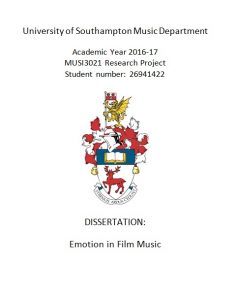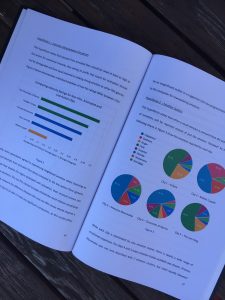How to Write a Dissertation
 In the second of our series on third year research projects, Beth Walker talks us through the steps of her project on film music: Over the course of my final year I gave myself the challenge of writing a 10,000 word dissertation titled ‘Emotion in Film Music’. This was my first time completing such an extensive academic project but it was definitely worth it (especially since it counted towards my degree!). Despite beginning this project with only vague ideas about what I wanted to include, I had known for a very long time I wanted the overall topic to be about emotion and music. I have always felt that film scores evoke indescribable feelings and so I was very keen to create my own survey to find out why. My main aims were to see if scores for animated films would be rated as more emotionally intense than those from live-action films; if there were patterns between the types of emotion evoked, which was achieved by presenting participants with emotion word clusters; and if previous musical education affected the intensity of emotion experienced by a listener. The survey also allowed me to discover whether personal factors influenced musical listening, and what musical elements most commonly evoked emotion.
In the second of our series on third year research projects, Beth Walker talks us through the steps of her project on film music: Over the course of my final year I gave myself the challenge of writing a 10,000 word dissertation titled ‘Emotion in Film Music’. This was my first time completing such an extensive academic project but it was definitely worth it (especially since it counted towards my degree!). Despite beginning this project with only vague ideas about what I wanted to include, I had known for a very long time I wanted the overall topic to be about emotion and music. I have always felt that film scores evoke indescribable feelings and so I was very keen to create my own survey to find out why. My main aims were to see if scores for animated films would be rated as more emotionally intense than those from live-action films; if there were patterns between the types of emotion evoked, which was achieved by presenting participants with emotion word clusters; and if previous musical education affected the intensity of emotion experienced by a listener. The survey also allowed me to discover whether personal factors influenced musical listening, and what musical elements most commonly evoked emotion.
After a comforting discussion with my supervisor who gave me the confidence to think ‘Yes, I can do this’, it was time to google like I’d never googled before. I gathered some ideas, attempting to break my thought process down into manageable sections, and hauled some very large books back from the library. I sat at my desk with a very daunting pile of texts in front of me, made myself a plan (which would soon be adapted as more reading was completed) and began my research. Even now, many weeks after the deadline, my personal books still have a multitude of coloured tags hanging from bookmarked pages that provided me with useful quotes and information. Mind-maps were also my close friends during the research process – I had maps for separate chapters, each with colourful branches containing unique ideas of mine, page numbers from useful books and lines that were all over the place, allowing me to visualise how I could link ideas and topics together.
Aside from the methodology, which I completed as the survey designs fell into place, and once I felt my mind-maps were large enough, I began writing my first chapter over the Christmas break. I was eager to get a head start on increasing the word count and was relieved I did so. As expected, there was much that changed over the next few months and the research was ongoing even whilst I was writing, but the early start was very helpful in the long run – especially when other deadlines had to take priority. As I gathered more and more information, the length of each chapter became a problem; I had to decide which sections of writing were imperative and four months later the final contents unfolded as follows:
Abstract – Introduction – Chapter 1: The History of Film Music – Chapter 2: The Leitmotif and its Role in Film Music – Chapter 3: Animation vs. Live action – Genre and Culture – Chapter 4: The Psychology of Music and Emotion – Methodology – Results – Conclusion – Bibliography – Appendix
I found the most enjoyable part to be the survey in which participants were required to listen to excerpts of film music without the visual context and answer questions. Hopefully the participants enjoyed completing it, although I’m not convinced social media enjoyed the spam! However, this method proved successful as I received almost 100 responses in roughly 2 weeks. Somehow I had managed to design my own survey that not only researched multiple hypotheses, but related back to concepts from every chapter. Once results were collected it was time to assemble the graphs… many graphs. I included the most relevant and significant results in the final dissertation and presented graphs that addressed my hypotheses.
And the writing was complete! But it was not over yet. Edit, edit, edit – that was my motto for the next 3 weeks. I was very impressed with myself over the time taken to tweak and improve sentences and reduce the word count (yes I’d managed to write more than 10,000 words!). It was this stage that proved to me how essential good time management was; had I started too late I would not have had enough time to edit. It was surprising how many extra things still needed doing – formatting references correctly, numbering pages, creating a contents page, making sure each chapter started on the right side of the book (a bit pedantic I know but I’m very particular about presentation) … the list was endless. I’m so glad I was organised. Finally, it was time to get my dissertation bound. I chose the slightly more expensive Southampton hardback as opposed to transparent plastic. After all the effort I had put into the work I wanted it to look nice! I was very proud to have completed the dissertation and consider it to be the best piece of work I’ve done during my university career.



![mindmap[1]](http://blog.soton.ac.uk/music/files/2017/07/mindmap1-1024x548.jpg)